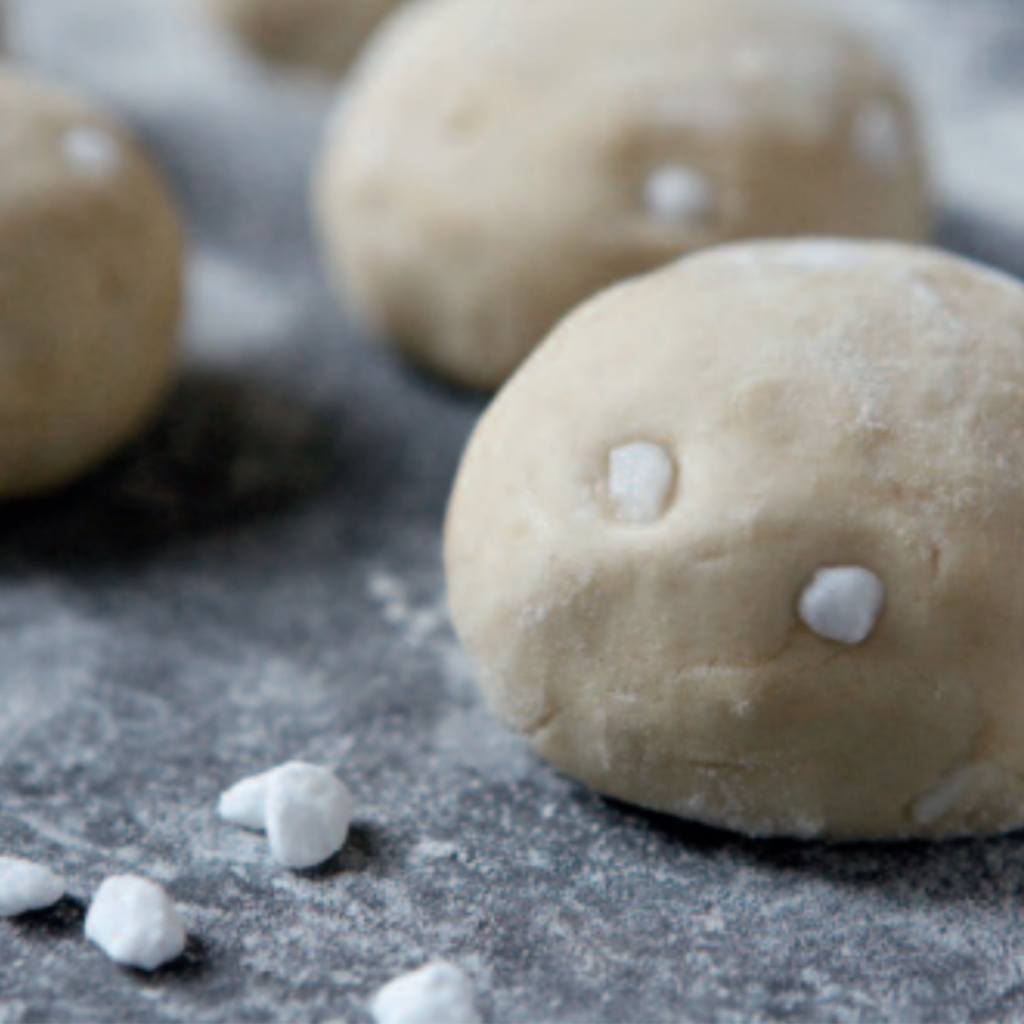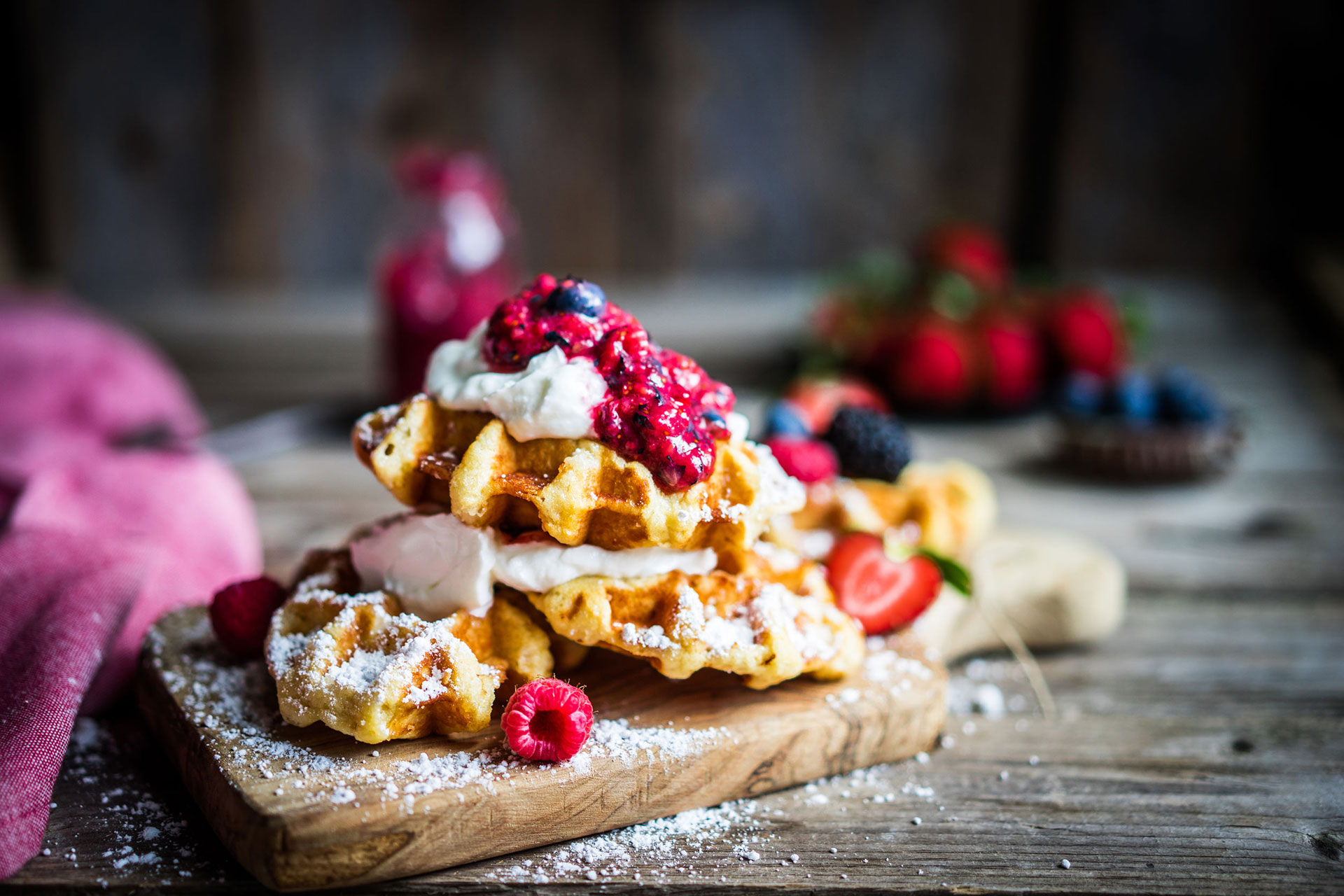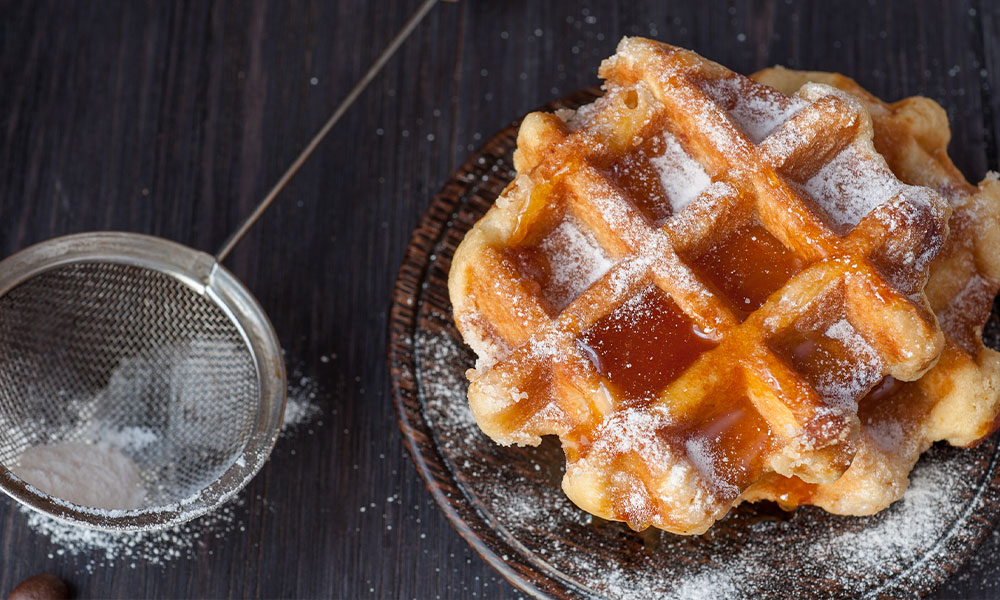
History of the Liege Waffle
Liege waffles, a beloved treat from the Belgian city of Liège, are a delightful twist on the traditional waffle. Unlike their lighter Brussels counterparts, Liege waffles are known for their rich, dense texture and caramelised sugar coating.
What is a Liege Waffle?
A Liege waffle is made with a yeast-leavened dough rather than a batter. The signature sweetness comes from pearl sugar – chunks of sugar that caramelise on the outside of the waffle as it cooks, giving it a distinctive, slightly crunchy texture.
Unlike traditional waffles, which are typically made from a batter, Liege waffles are made from a brioche-like yeast-based dough. The dough is richer and thicker, resulting in a waffle that is soft and chewy on the inside with a caramelised, slightly crunchy exterior. Compared to Belgian/Brussels waffles, they are much denser and sweeter.
Where are Liege Waffles From?
Liege waffles originate from Liège, a city in the French-speaking region of Wallonia in Belgium. They were reportedly invented in the 18th century by the chef of the Prince-Bishop of Liège.
History of the Liege Waffle
Legend has it that the recipe was first created by the chef of the Prince-Bishop of Liège, who requested a pastry filled with the newly introduced pearl sugar.
The result was a dense, sweet waffle with a caramelised sugar coating, which became an instant hit. The Prince-Bishop was so greatly impressed by the aroma and taste of the Liege waffle that the recipe was shared over Belgium and passed down over time. The Liege waffle was first introduced as Gaufre de Liège – waffle of Liege or Liege waffle.
Over the years, the Liege waffle has maintained its popularity, evolving into a versatile treat that can be enjoyed in various ways. It can now commonly be found as a street food across Belgium and beyond.

Pearl Sugar in Liege Waffles
One of the key features of the Liege waffle is the inclusion of pearl sugar, a special type of sugar that remains intact during the mixing part of the baking process.
As the waffle cooks, these sugar pearls melt and create pockets of caramelised sweetness throughout the dough, giving the waffle its signature flavour and texture. The pearl sugar also contributes to the waffle’s characteristic golden-brown, slightly crispy crust.
How Are Liege Waffles Served?
Liege waffles are traditionally eaten warm and plain, as the pearl sugar within it makes it sweet enough on its own without the need for syrups and toppings. However, many people do love to add additional toppings to their Liege waffles.

Best Liege Waffle Toppings
While Liege waffles are delicious on their own, they can be enhanced with various toppings. These toppings can complement the rich sweetness and chewy texture of the Liege waffle, creating a delightful treat. Popular choices include:
- Whipped cream
- Nutella or other chocolate spreads
- Fruit, such as strawberries, bananas, or blueberries
- Caramel or salted caramel sauce
- Powdered sugar
- Ice cream (especially vanilla or caramel)
- Nuts (like chopped hazelnuts or almonds)
Liege Waffles vs Belgian Waffles
Liege waffles and Belgian waffles differ in several key ways:
- Dough vs. Batter – Liege waffles use a thick, yeast-based dough, while Belgian waffles are made from a lighter batter.
- Texture – Liege waffles are denser and chewier with a crispy, caramelised exterior, while Belgian waffles are lighter, airier, and have a crisp exterior with a soft inside.
- Shape – Liege waffles have an irregular, rounder/oval shape, whereas Belgian waffles are typically larger and rectangular with deep pockets (although sometimes round depending on the waffle maker used).
- Sweetness – Liege waffles are sweeter due to the caramelised pearl sugar, whereas Belgian waffles are more neutral and often served with toppings like whipped cream, fruit, and syrup.
Did you know…
The first recorded ‘waffles’ were similar to wafers and cooked between two metal plates!
Popular Types of Waffles for Cafes
There are four waffle types found in cafes worldwide:
- Belgian waffle – First debuted in 1958 at a world trade fair in Brussels. Large serving sizes and lots of pockets, perfect for catching syrup.
- Liege waffle – Adapted from brioche bread and studded with pearl sugar for more crunch, has a caramelised outside to avoid soggy waffles!
- Stroopwafel – Thin and round waffles sandwiched with caramel filling – more of a biscuit than a waffle but a perfect treat with coffee. Rest on top of your mug to warm up the gooey caramel!
- American waffle – Designed thinner and denser than the Belgian waffle and made with smaller pockets.

Why Choose Liege Waffles?
Although the Liege and the Belgian Waffle were both founded in Belgium, they are very different! Liege waffles have a distinct crunchy and bread-like texture, whereas the Belgian waffle is lighter and softer.
Liege waffles are the most popular waffle choice for cafes and street vendors due to their enticing aroma, sugar caramelised coating, sweet flavour and ideal portioned serving size.
If you are looking to add Liege waffles to your cafe’s menu, then we have a range of pre-made Liege waffles and Liege waffle mix wholesale.
Our Easy Belgian Waffles are pre-cooked and individually wrapped for a quick and convenient serving in your cafe. Alternatively, our Liege waffle dough is made using high-quality ingredients following an authentic recipe. The waffle dough balls are supplied pre-portioned and frozen for longevity, to reduce product waste, and to ensure serving consistency!
